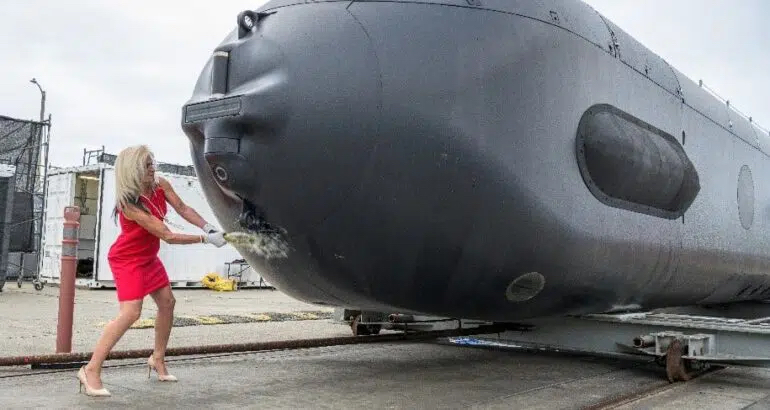John Grady

Pre-commissioning unit (PCU) Hyman G. Rickover (SSN-795) seen prior to a christening ceremony at General Dynamics Electric Boat shipyard facility in Groton, Conn., on July 31, 2021. US Navy Photo
To keep an edge against the rapidly expanding Chinese navy and still-potent Russian submarine force, the U.S. needs a widely distributed force of crewed and uncrewed surface and undersea vessels, as well as satellites and uncrewed aerial systems, according to a new study in undersea warfare.
“To sustain its offensive undersea advantage, the U.S. Navy will need to take some lessons from air warfare and begin supporting submarines with systems designed to suppress or destroy enemy undersea defenses,” The authors of the report, called “Fighting into the Bastions,” argue. “This imperative will fundamentally shift the paradigm for U.S. submarine operations from ‘alone and unafraid’ to ‘it’s all about team.’”
That would mean a narrower set of missions for attack submarines, but expanding roles for manned surface vessels like Landing Ship Docks, towed buoys, improved seabed sensors and developing laser communications, the report said.
“The submarine industrial base is at maximum capacity and a few more hulls will not make a substantial difference against the PLA’s growing ASW capacity, which needs only to harass U.S. SSNs to succeed,” authors Bryan Clark and Timothy Walton concluded.
At last week’s event, Chuck Fralick, chief technology officer of Leidos Maritime, said that “using a $3 billion capability is not the best way” to conduct seabed warfare or anti-submarine warfare. “What we need to do [is field] multi-mode platforms” that can “go deep, with persistence, with command and control,” he added.
Integrating capabilities like jamming and mine hunting “is the trick of it,” Fralick said. “Tethers back to the boat are not likely.”
Kevin Decker, chief executive officer of Ocean Aero, a data collection firm, said there was no need to replicate a large platform like a submarine to gather huge amounts of data that can be turned into actionable intelligence or carry out other missions. “What if you have 5,000 of them?” he said. Such small platforms could confuse an adversary’s sensors.
As the report said on anti-submarine warfare, “uncrewed vehicles can also enable U.S. undersea forces to exploit active sonar to detect and track increasingly quiet [Chinese] and Russian submarines without risking counter-detection of a crewed US ship.”
Retired submariner Adm. Jaime Foggo said the war in Ukraine underscores the danger of mines, including many left over from both world wars. He pointed toward a Romanian minesweeper damaged last fall by a floating mine that was probably released by the Russians.

Fralick said Boeing’s Orca Extra Large Unmanned Undersea Vessel was a step in the right direction, but not the final answer. The Navy has ordered five for countermine operations, anti-submarine, electronic warfare and strike missions.
Capturing and sharing high-quality images remains difficult. “Communications has to be solved to re-task” unmanned systems, but “we’ll get there,” said Fralick. Decker said establishing a “mesh network” of satellite unmanned aerial surface systems capable of operating in a contested environment would improve communication even if it were only limited to the horizon.
Energy poses the largest challenge, according to Fralick and the other panelists. Descending and ascending consume a large amount of energy, as does command and control. Decker said the Navy is focused on making batteries rechargeable to enable longer missions.
Decker said the technology to improve situational awareness on and below the surface is largely in place, but to survive, platforms must be able to deploy “eyes,” comb for seabed mines or sense cables without revealing their location.
Foggo said the Navy should explore ways of launching uncrewed drones other than through torpedo tubes as plans move along on SSN (X), the next generation attack submarine to succeed Virginia-class and Seawolf-class submarines.
“(P)ayload space on a submarine comes at a premium,” the report said. “[E]very UUV that takes up a torpedo stow or missile cell displaces a weapon that can be reloaded only at a ship or pier outside of the conflict area. Therefore, submarine-launched medium UUVs (MUUVs) that can be carried only in the torpedo room should be reusable and few. In contrast, small UUVs (SUUVs) that can be carried in external countermeasure launchers or lockers inside the submarine” should be plentiful.
Foggo and the report noted that SSN(X) costs are estimated to top $6 billion per sub, about twice the price tag for the latest Virginia-class deliveries. The report suggested that “investments in improved sound silencing could be weighed against those in active sensor countermeasures and longer-range weapons that could provide equivalent improvements in survivability.”
No comments:
Post a Comment